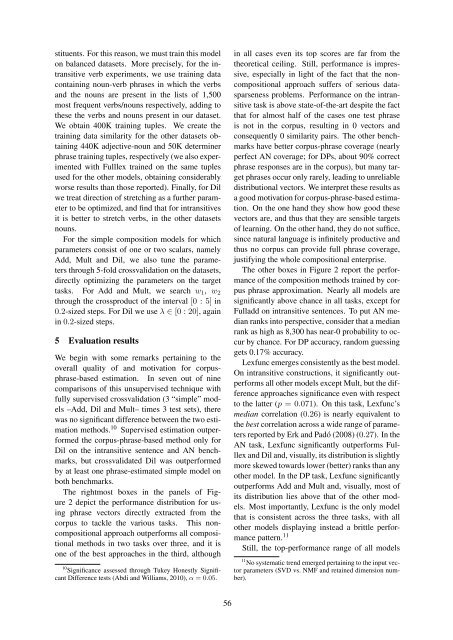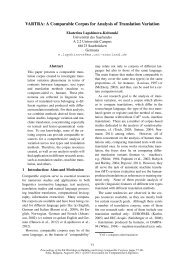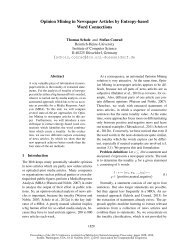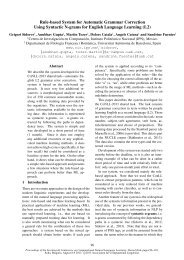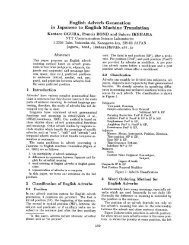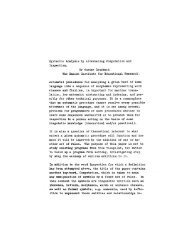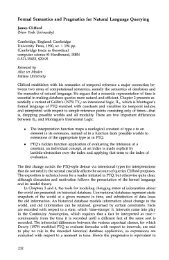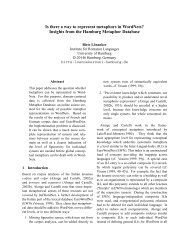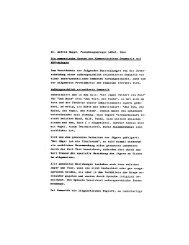Vector Space Semantic Parsing: A Framework for Compositional ...
Vector Space Semantic Parsing: A Framework for Compositional ...
Vector Space Semantic Parsing: A Framework for Compositional ...
Create successful ePaper yourself
Turn your PDF publications into a flip-book with our unique Google optimized e-Paper software.
stituents. For this reason, we must train this model<br />
on balanced datasets. More precisely, <strong>for</strong> the intransitive<br />
verb experiments, we use training data<br />
containing noun-verb phrases in which the verbs<br />
and the nouns are present in the lists of 1,500<br />
most frequent verbs/nouns respectively, adding to<br />
these the verbs and nouns present in our dataset.<br />
We obtain 400K training tuples. We create the<br />
training data similarity <strong>for</strong> the other datasets obtaining<br />
440K adjective-noun and 50K determiner<br />
phrase training tuples, respectively (we also experimented<br />
with Fulllex trained on the same tuples<br />
used <strong>for</strong> the other models, obtaining considerably<br />
worse results than those reported). Finally, <strong>for</strong> Dil<br />
we treat direction of stretching as a further parameter<br />
to be optimized, and find that <strong>for</strong> intransitives<br />
it is better to stretch verbs, in the other datasets<br />
nouns.<br />
For the simple composition models <strong>for</strong> which<br />
parameters consist of one or two scalars, namely<br />
Add, Mult and Dil, we also tune the parameters<br />
through 5-fold crossvalidation on the datasets,<br />
directly optimizing the parameters on the target<br />
tasks. For Add and Mult, we search w 1 , w 2<br />
through the crossproduct of the interval [0 : 5] in<br />
0.2-sized steps. For Dil we use λ ∈ [0 : 20], again<br />
in 0.2-sized steps.<br />
5 Evaluation results<br />
We begin with some remarks pertaining to the<br />
overall quality of and motivation <strong>for</strong> corpusphrase-based<br />
estimation. In seven out of nine<br />
comparisons of this unsupervised technique with<br />
fully supervised crossvalidation (3 “simple” models<br />
–Add, Dil and Mult– times 3 test sets), there<br />
was no significant difference between the two estimation<br />
methods. 10 Supervised estimation outper<strong>for</strong>med<br />
the corpus-phrase-based method only <strong>for</strong><br />
Dil on the intransitive sentence and AN benchmarks,<br />
but crossvalidated Dil was outper<strong>for</strong>med<br />
by at least one phrase-estimated simple model on<br />
both benchmarks.<br />
The rightmost boxes in the panels of Figure<br />
2 depict the per<strong>for</strong>mance distribution <strong>for</strong> using<br />
phrase vectors directly extracted from the<br />
corpus to tackle the various tasks. This noncompositional<br />
approach outper<strong>for</strong>ms all compositional<br />
methods in two tasks over three, and it is<br />
one of the best approaches in the third, although<br />
10 Significance assessed through Tukey Honestly Significant<br />
Difference tests (Abdi and Williams, 2010), α = 0.05.<br />
in all cases even its top scores are far from the<br />
theoretical ceiling. Still, per<strong>for</strong>mance is impressive,<br />
especially in light of the fact that the noncompositional<br />
approach suffers of serious datasparseness<br />
problems. Per<strong>for</strong>mance on the intransitive<br />
task is above state-of-the-art despite the fact<br />
that <strong>for</strong> almost half of the cases one test phrase<br />
is not in the corpus, resulting in 0 vectors and<br />
consequently 0 similarity pairs. The other benchmarks<br />
have better corpus-phrase coverage (nearly<br />
perfect AN coverage; <strong>for</strong> DPs, about 90% correct<br />
phrase responses are in the corpus), but many target<br />
phrases occur only rarely, leading to unreliable<br />
distributional vectors. We interpret these results as<br />
a good motivation <strong>for</strong> corpus-phrase-based estimation.<br />
On the one hand they show how good these<br />
vectors are, and thus that they are sensible targets<br />
of learning. On the other hand, they do not suffice,<br />
since natural language is infinitely productive and<br />
thus no corpus can provide full phrase coverage,<br />
justifying the whole compositional enterprise.<br />
The other boxes in Figure 2 report the per<strong>for</strong>mance<br />
of the composition methods trained by corpus<br />
phrase approximation. Nearly all models are<br />
significantly above chance in all tasks, except <strong>for</strong><br />
Fulladd on intransitive sentences. To put AN median<br />
ranks into perspective, consider that a median<br />
rank as high as 8,300 has near-0 probability to occur<br />
by chance. For DP accuracy, random guessing<br />
gets 0.17% accuracy.<br />
Lexfunc emerges consistently as the best model.<br />
On intransitive constructions, it significantly outper<strong>for</strong>ms<br />
all other models except Mult, but the difference<br />
approaches significance even with respect<br />
to the latter (p = 0.071). On this task, Lexfunc’s<br />
median correlation (0.26) is nearly equivalent to<br />
the best correlation across a wide range of parameters<br />
reported by Erk and Padó (2008) (0.27). In the<br />
AN task, Lexfunc significantly outper<strong>for</strong>ms Fulllex<br />
and Dil and, visually, its distribution is slightly<br />
more skewed towards lower (better) ranks than any<br />
other model. In the DP task, Lexfunc significantly<br />
outper<strong>for</strong>ms Add and Mult and, visually, most of<br />
its distribution lies above that of the other models.<br />
Most importantly, Lexfunc is the only model<br />
that is consistent across the three tasks, with all<br />
other models displaying instead a brittle per<strong>for</strong>mance<br />
pattern. 11<br />
Still, the top-per<strong>for</strong>mance range of all models<br />
11 No systematic trend emerged pertaining to the input vector<br />
parameters (SVD vs. NMF and retained dimension number).<br />
56


